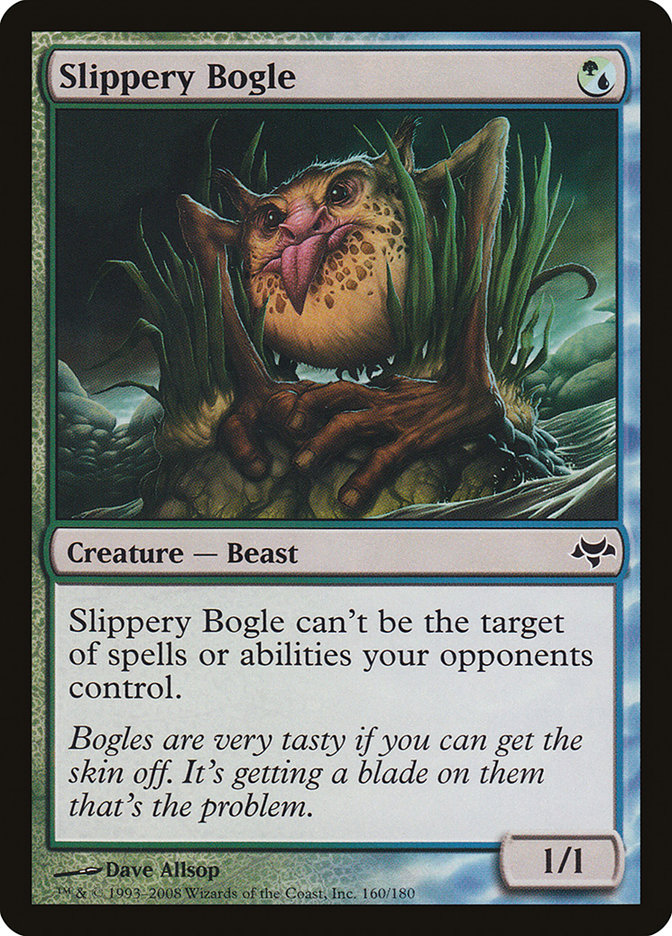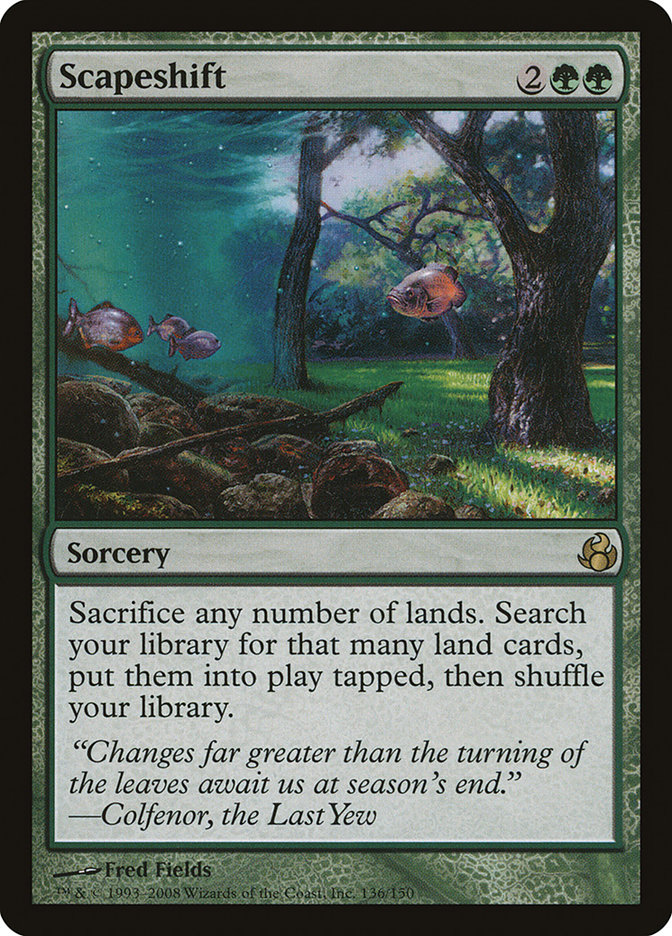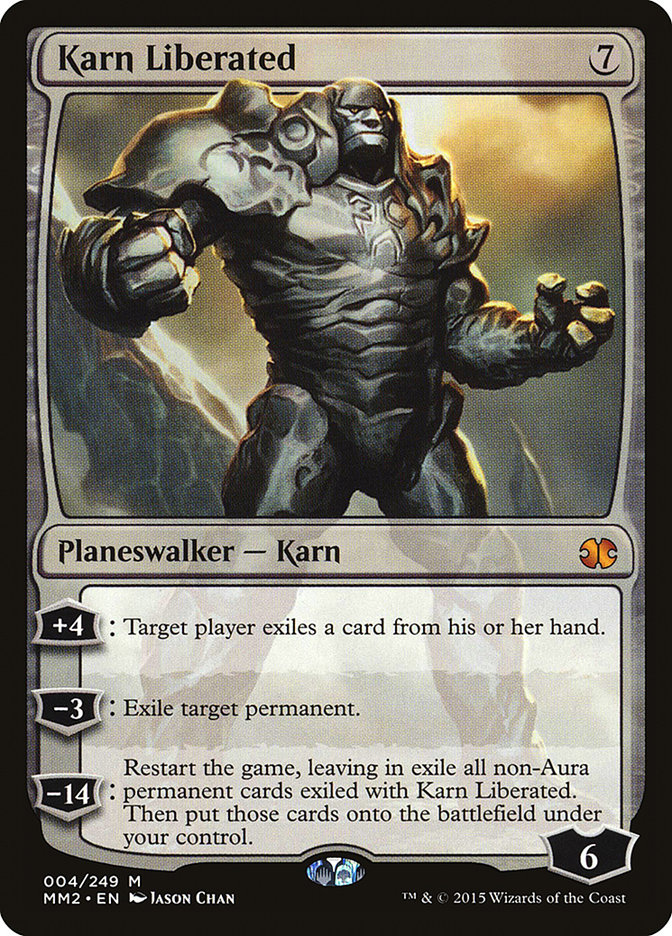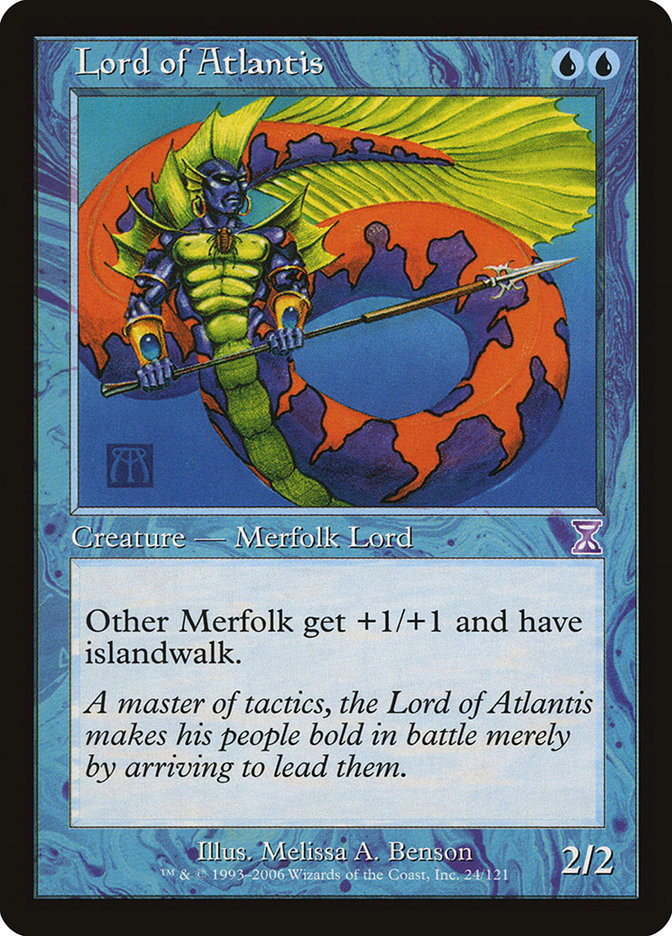904 players gathered in Indianapolis for the Standard Open, and after the first day, only 79 players moved on. By the end of the day, while Nicholas Byrd had won the event, Death’s Shadow had reasserted itself as the dominant player in Modern.
These are the most basic facts.
What can we learn by digging a little deeper?
The Most Common Card
If you do the work of looking through the decklists from the event, you’ll quickly find that there is a singular standout spell that is more likely to be seen in a deck than any other. You probably won’t be surprised to learn it is Fatal Push.
Fatal Push had started emerging even before GP Vancouver, but now, in Death’s Shadow world, it is even more clearly a critical element of many decks strategies.
Even where it might not be the most obvious card choice, we’re still seeing it.
Creatures (4)
Lands (20)
Spells (36)

Do you see it? There, waiting in the sideboard, are two copies of Fatal Push among a tiny handful of creature removal cards in Nicholas Byrd’s 75 cards. The others are a maindeck Slaughter Pact, which Byrd can choose to cast while winning the game with Ad Nauseam, and a single sideboard Damnation.
Only two of the Top 8 don’t run the card, and of the thirteen 12-3 and better finishers, the only decks not running the card are the decks that don’t have mana to cast it. For what it is worth, all of those five decks not running Fatal Push are running the white Fatal Push, Path to Exile.
Perhaps that is why Death’s Shadow’s dominance was only clear, rather than overwhelming.
Digging Deeper into Numbers
One of the first things to take note of is that the format had a ton of diversity. All told, 32 distinct archetypes showed up on Day 2. This is a pretty shockingly diverse format towards the top end of the field, with only roughly 8% of the event making the 7-2 or better record required for Day 2.
Now, for some of these archetypes, this may represent the pinnacle of what the archetype can achieve. Without picking on any specific choice, it is possible that the peak of what G/R Land Destruction can do is 11-4, but with only two players playing it in Day 2, we can’t be fully certain of that. Similarly, with only two players in Day 2 playing Ad Nauseam, maybe we could say that the archetype is incredible, because 50% of the people playing it won the tournament.
Obviously, there are limitations to what can be delved. I don’t have access to all 904 decklists to be able to break things down, archetype by archetype, on how each deck performed That doesn’t mean that there aren’t conclusions to be made, however.
Some first important numbers are these:
41.8% of players in Day 2 finishing 11-4 or better.
16.5% of players in Day 2 finishing 12-3 or better (tied for Top 8).
These are our guide markers. Conversion rates above these numbers are correlated with the deck being a good choice for the event.
While very few archetypes were played by enough people for us to get a full read on those archetypes without access to the full 904 lists. For example, Garrett Strause and Richie Sledz were the only players to play Grixis Delver and Grixis Control, respectively, in the entire Day 2 field. We can’t get a good read on either archetype with so few players playing it, and even if we merged the two – quite inadvisable, since they aren’t just different archetypes, they are different macro-archetypes, regardless of sharing the same colors – we still wouldn’t have information worthy of high confidence.
But we can actually make some conclusions on a few decks.
3 G/W Hexproof, 11-4+: 0%, 12-3+: 0%
3 Scapeshift, 11-4+: 33%, 12-3+: 0%
G/W Hexproof did quite poorly on Day 2. Not a single one of the three players playing it managed to break into the eleven-win-or-better category. Importantly, it was the only deck with three or more players with this dubious distinction. It seems fair to conclude that in a metagame this powerful, choosing G/W Hexproof is choosing to roll the dice a large number of times.
While Scapeshift had a similar result, with only one of its three players getting to eleven wins, this is actually a pretty large distinction, since it means that Scapeshift was at least able to peek over that hump. My expectation is that, unlike Hexproof, Scapeshift could potentially be a player moving forward in Modern, albeit it isn’t likely, though with only three players, it is hard to be fully confident.
5 G/X Tron, 11-4+: 20%, 12-3+: 0%
5 Merfolk, 11-4+: 20%, 12-3+: 0%
Merfolk and Green Tron decks each finished about the same, with a single representative each cracking into the eleven-win bracket.
Here, we have the Scapeshift experience, only compounded. With literally all of these archetypes, Merfolk, Tron, G/W Hexproof, and Scapeshift, if anyone playing them pushed a magical button at the beginning of the event that would let them swap places with a random competitor on Day 2, they should push the button. The higher numbers of players we have for Merfolk and Tron just give slightly greater confidence that they are poor choices.
There are a huge slew of decks barely played by anyone in Day 2; these “Others” were all played by, at most, two people. Individually, it unreasonable to make a particular conclusion, but collectively, “Other” is almost in line with the “Random” choice, our baseline from above:
27 “Other,” 11-4+: 40.7%, 12-3+: 14.8%
“79” “Random,” 11-4+: 41.8%, 12-3+: 16.5%
One thing this tells us is that Modern is far from sewed up. Somewhere in that swarm of “Other” is enough success that I believe express potential for new permanent shifts in the metagame. Whether it is Ad Nauseam or some variety of Grixis, Revolt Zoo, or Lantern Control, to me, the data suggest the potential for additional change.
Creatures (7)
Lands (22)
Spells (31)

Take Richie Sledz’s fourth-place finish with Grixis Control. This is a tautly curved deck, packed with a ton of great removal, four Snapcaster Mage, and more card advantage besides that. He handily defeated Justin Cohen piloting Death’s Shadow. Of all of the archetypes out there to pay attention to from the “Other” category, this is one of the ones that I think could make the translation from margins to center.
Creatures (32)
- 2 Kird Ape
- 2 Simian Spirit Guide
- 4 Wild Nacatl
- 4 Goblin Guide
- 4 Burning-Tree Emissary
- 4 Experiment One
- 4 Reckless Bushwhacker
- 4 Hidden Herbalists
- 4 Narnam Renegade
Lands (17)
Spells (11)
Sideboard

This is another deck I think might make some moves. Michael Stewart went 5-1 on Day 2, missing out on tiebreaks by only a few percentage points. Wildly fast, the deck also has a powerful natural strength versus Death’s Shadow: it often hits in big, wide waves, so an opposing Death’s Shadow might never be in a position to attack in a scary way. Even if it can, maindeck Narnam Renegade is surprisingly annoying, and sideboard Path to Exile helps in the fight as well.
More Representation
If you wonder why I’m framing Death’s Shadow as the center of this, it isn’t just because of hype, it’s because of numbers. Death’s Shadow placed a whopping fifteen players into Day 2, easily more than the next two archetypes combined (and one of those archetypes was itself combined).
Furthermore, Death’s Shadow had the absolute best representation at the top of the field. Fully 60% of Death’s Shadow players in Day 2 finished at 11-4 or better. Especially given that it was the most-represented archetype as well, that is absolutely remarkable. Furthermore, it was also the most-represented deck at 12-3!
Let’s line it up against the other “best decks,” i.e., the decks that did well enough that you wouldn’t be acting rationally to push a button to randomly swap with another Day 2 competitor.
15 Death’s Shadow, 11-4+: 60%, 12-3+: 26.7%
7 G/B(x) Midrange: 11-4+: 57.1%, 12-3+: 14.3%
6 Bant Eldrazi: 11-4+: 33.3%, 12-3+: 33.3%
4 Burn: 11-4+: 50%, 12-3+: 50%
4 Abzan Company: 11-4+: 50%, 12-3+: 0%
Likely, you’ve seen a lot of takes on the best way to build Death’s Shadow. I think that there are numerous small choices that one could make, but of all of the builds that I’ve seen thus far, I really do prefer the one Justin Cohen took to Indianapolis.
Creatures (12)
Planeswalkers (3)
Lands (18)
Spells (27)

Yes, Michael Majors did better in the Swiss, and with four Fatal Push maindeck in the version Michael Majors played, he is better at killing an opposing Death’s Shadows. However, what I like about Justin’s build is that he seems more prepared for any opponent, even those who might have a plan that is great against Death’s Shadow.
I expect two things at the SCG Tour stop in Dallas: more Death’s Shadow and more anti-Death’s Shadow. In that world, it might mean just play the Majors build (or a recent GerryT build), but I have a feeling a significant enough portion of the metagame will be in the “beat it” camp, and so I prefer Justin’s.
Creatures (14)
Planeswalkers (4)
Lands (22)
Spells (20)

One of the “beat it” plans is certainly Abzan (and the G/B/X Midrange decks like Jund and G/B Rock that are its cousins).
This category of deck was behind only Death’s Shadow in its ability to bring players to a top record of 11-4 or better. However, it did falter a little bit at the very top of the field, which may just speak to some matchup-specific weaknesses. Tilsen, for example, beat Michael Majors in three games and easily beat Richie Sledz in two, yet could not touch Nicholas Byrd in the finals, losing 0-2. Modern, being what it is, offers plenty of challenges for these kinds of decks, usually in the form of big mana (Tron, Scapeshift) or big turn (Ad Nauseam, Storm). Especially without Dark Confidant, this deck is settling in on a “win fairly and powerfully” strategy that can certainly be trumped.
Creatures (12)
Lands (19)
Spells (29)

If G/B/X Midrange strategies are a straightforward way to fight Death’s Shadow, Burn is a hotly contested one. Many Death’s Shadow proponents claim that Burn is actually a quite good matchup, flying in the face of inexperienced intuition.
One potential reason why this disparity in opinion is tactical: unlike Revolt Zoo, Burn doesn’t typically have a turn where a huge amount of damage is unleashed at once. Rather, it puts a regular stream of heat onto an opponent, which has the unfortunate effect of pre-empowering Death’s Shadow into a threat requiring an answer. A tactical change of withholding some of that damage for that matchup can certainly affect results.
For Burn at Indianapolis, the results were certainly remarkable. Two of the four players had the record to Top 8, though they missed out. The top finisher, Jason Phimister’s list, is a pretty straightforward Naya build, but it does have two fairly notable components.
First, it runs four copies of Lightning Helix. Lightning Helix is not a great spell for Burn. However, versus Death’s Shadow, it can potentially be a card that will keep a player alive for another turn. Using it versus an opponent doesn’t help, as it grows Death’s Shadow, but even as “just” a bad Healing Salve, it can sometimes be enough to hold off the opponent for a lethal counterattack. In a pinch, chump-blocking Death’s Shadow and using the Lightning Helix on the opponent can work, though you’ll have to hope there aren’t any Ghor-Clan Rampagers or Temur Battle Rages in the mix.
The final two decks, Bant Eldrazi and Abzan Company, represent opposite ends of a spectrum. Bant Eldrazi actually significantly underperformed on Day 2 overall, but two of its pilots made the Top 8, where it was impressively overrepresented. Conversely, Abzan Company overperformed at the lower levels, with half of its players with eleven wins…and none with twelve. With as few players as Abzan Company had, it is hard to make predictions with any degree of confidence, but there were enough representative piloting Bant Eldrazi, and some things seem more certain.
In the case of Bant Eldrazi, I have a feeling that this is a deck that requires a higher degree of mastery or a sufficient threshold of Death’s Shadow hate to get exemplary returns.
Creatures (25)
- 1 Birds of Paradise
- 4 Noble Hierarch
- 4 Drowner of Hope
- 4 Eldrazi Skyspawner
- 4 Eldrazi Displacer
- 4 Reality Smasher
- 4 Thought-Knot Seer
Lands (24)
Spells (11)

If we look at this deck and imagine it in a late-game versus Death’s Shadow, it can be very hard for a Death’s Shadow player to seal the deal. Between Drowner of Hope and other incidental Eldrazi Scion creations, a game can end rapidly even without an Eldrazi Displacer to seal the deal. With only the bare minimum of direct damage available, a Death’s Shadow pilot may be effectively locked out of many games.
Surviving and maneuvering the game to that point is where mastery and a decklist detail can matter. Dan Musser is a well-known factor on the SCG Tour, and he has a long history of results. Both Dan Musser and John Sauer brought significant tools to defeat Death’s Shadow, including several maindeck Engineered Explosives, and decisions to shirk on cards like this may also be why other players had less success with the archetype.
Final Thoughts
In Modern, one constant truism has been “play what you know.” However, in the current moment, with Death’s Shadow’s effect not just hype or hyperbole but reality, a better truism might be this:
“Know what you play.”
There are only a handful of archetypes that I would consider for the SCG Tour Stop in Dallas this weekend.
1 – Death’s Shadow
2 – G/B(/X) Midrange*
3 – Burn
4 – Grixis Control
5 – Lantern
6 – Ad Nauseam
7 – Bant Eldrazi
* I feel like I’d be most likely to go straight G/B, though the data suggest Abzan is the proper choice.
The bolded choices are the ones most supported by the data from Indianapolis, but that doesn’t mean that the other choices are less reasonable, just that there is less information. I’m likely always going to include Lantern on my lists, if only because I know the deck and could feel comfortable with a setup of the deck that took Death’s Shadow more into account. Grixis Control, Ad Nauseam, and Bant Eldrazi don’t have wildly conclusive evidence that they’d be good choices, but there are enough bits of supporting evidence that I’m inclined to think they’d be a good choice.
Even beyond those choices, the Modern metagame is wildly diverse, and especially given the sense I have after Indianapolis, if you put in the good work required to figure out the Death’s Shadow matchup, any deck you select that you know well could be a great choice.
Good luck, everyone! I’m excited to see what comes out of Texas this weekend!









